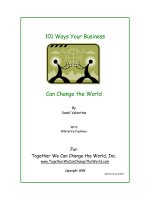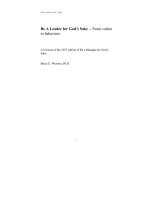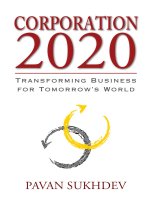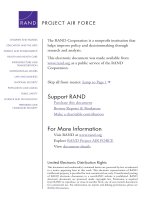Corporation 2020: Transforming Business for Tomorrow's World
Bạn đang xem bản rút gọn của tài liệu. Xem và tải ngay bản đầy đủ của tài liệu tại đây (3.38 MB, 294 trang )
All is not well with today’s market-centric
economic model. Although it has delivered
enormous wealth over the last half century and
pulled millions out of poverty, it is recession-
prone, leaves too many unemployed, creates
ecological scarcities and environmental risks, and
widens the gap between the rich and the poor.
e model for today’s corporations—formed over
the last two centuries in a world of seemingly
limitless resources—is clearly broken. Around $1
trillion a year in perverse subsidies and needless
barriers to entry for alternative solutions
maintain “business-as-usual” while obscuring its
environmental and societal costs. e result is the
social inequity, environmental degradation, and
political manipulation that are the unwanted
by-products of today’s corporations.
We aren’t stuck with this dysfunctional cor-
porate model. If it is to enact the comprehensive
approach we now need, however, business needs
a new DNA. In this sweeping vision for a new
species of corporation, Pavan Sukhdev p roposes
the new incentives and regulations that will en-
able corporations to increase human well-being
and social equity, decrease environmental risks
and ecological losses, and continue to generate
strong profits. e status quo is no longer an op-
tion. Corporation 2020 can become a reality in
the next decade—and it must if we are to avert
catastrophic social imbalance and ecological
harm.
From his insightful look into the history
of the corporation to his thoughtful discussion
of the steps needed to craft a better corporate
model, Corporation 2020 offers an important
and hopeful vision for the role of business in
shaping a more equitable, sustainable future.
2020
CORPORATION
CORPORATION 2020
Pavan Sukhdev Pavan Sukhdev
SUKHDEV
Transforming Business
for Tomorrow’s World
BUSINESS | ENVIRONMENT
Advance Praise for Corporation 2020
“Much has recently been written about how a new wave of ‘green’ corporations is just around the
corner, an endogenously transformed phalanx of knights in shining armour just waiting to rescue
us. Pavan Sukhdev says ‘not so,’ but he also shows, with consummate skill and clarity, what exog-
enous changes can be made to re-engineer the ‘social contract’ between society and corporations in
the 21st Century.”
—Achim steiner, Executive Director, United Nations Environment Programme
“e ideas and assertions in this book blow well past ‘insightful’ and edge toward ‘revolution-
ary’ insofar as they expose major fallacies in our most basic assumptions about what we call our
‘economy.’ It’s an equally important exposure for corporate leaders and leaders of the movement
for environmental sustainability, because both need to move beyond the ‘infancy phase’ in terms
of truly understanding and acknowledging the value of natural resources. A seriously inspiring
and, ultimately, very hopeful piece of work.”
—edwArd norton, United Nations Goodwill Ambassador for Biodiversity
“Pavan Sukhdev writes with extraordinary clarity, compassion, and conscience, laying the ground
for a new, whole-system economics. Recognizing that all human activity is part of nature, and
that nature is essential for human well-being, Sukhdev creates a framework for the restoration
of human and natural systems. Corporation 2020 brilliantly lays out a pathway for corporations,
countries, and citizens towards the earth’s health.”
—JonAthAn F. P. rose, President, Jonathan Rose Companies
“When Pavan Sukhdev comes along and writes an extraordinary book, and backs it up with an
extraordinary campaign and a really good website to promote . . . a change in the basic culture,
definition, and orientation of corporations in our society, it’s very timely, and it’s very important
to take what he has to say seriously.”
— JAmes GustAve sPeth, Professor of Law, Vermont Law School and Distinguished
Senior Fellow, Demos
Jacket design and illustration by Maureen Gately
In 2008, PAvAn sukhdev took a sabbati-
cal from Deutsche Bank, where he’d worked for
fifteen years, to write two reports on the green
economy. His “Green Economy Report” for
the United Nations Environment Programme
(UNEP) synthesized years of research to show
that environmentally sound development is not
a bar to growth, but rather a new engine for
growing wealth and creating employment in the
face of persistent poverty. His groundbreaking
“TEEB” report counted the global economic
benefits of biodiversity, encouraging countries to
develop and publish “natural capital accounts”
tracking the value of natural wealth alongside
traditional financial measures.
Sukhdev has chaired the Global Agenda
Council on Biodiversity and Ecosystems for the
World Economic Forum and was a speaker at
the World Economic Forum meetings at Davos
in 2010 and 2011. He serves on the boards of
Conservation International and the Stockholm
Resilience Centre. In 2011, he was named a
Visiting Fellow at Yale University, where he was
awarded a McCluskey Fellowship.
Corporation 2020
CORPORATION 2020
Transforming Business for Tomorrow’s World
Pavan Sukhdev
Washington | Covelo | London
Copyright © 2012 Pavan Sukhdev
All rights reserved under International and Pan-American Copyright
Conventions. No part of this book may be reproduced in any form or by
any means without permission in writing from the publisher: Island Press,
Suite 300, 1718 Connecticut Ave., NW, Washington, DC 20009
ISLAND PRESS is a trademark of the Center for Resource Economics.
Library of Congress Cataloging-in-Publication Data
Sukhdev, Pavan.
Corporation 2020 : transforming business for tomorrow’s world /
Pavan Sukhdev.
p. cm.
Includes bibliographical references and index.
ISBN 978-1-61091-238-9 (cloth : alk. paper) ISBN 1-61091-238-1
(cloth : alk. paper) ISBN 978-1-61091-239-6 (pbk. : alk. paper) ISBN
1-61091-239-X (pbk. : alk. paper) 1. Social responsibility of business.
2. Corporations Environmental aspects. 3. Industries Environmental
aspects. I. Title.
HD60.S8844 2012
658.4’08 dc23
2012020609
ISBN-13: 978-1-61091-238-9 (cloth)
ISBN-13: 978-1-61091-360-7 (e-book)
Printed on recycled, acid-free paper
Manufactured in the United States of America
10 9 8 7 6 5 4 3 2 1
Keywords: Island Press, economics, sustainability, business, corporate
responsibility, corporate externalities, environmental commons,
sustainable economy
To today’s students, tomorrow’s corporate leaders
This is your book, make it happen
vii
Contents
Foreword ix
Acknowledgments xiii
Introduction 1
Chapter 1. The Legal History of the Corporation 15
Chapter 2. The Great Alignment: 1945–2000 25
Chapter 3. Corporation 1920 49
Chapter 4. Through the Looking Glass of Corporate
Externalities 67
Chapter 5. Incorporating Externalities 91
Chapter 6. Accountable Advertising 111
Chapter 7. Limiting Financial Leverage 133
Chapter 8. Resource Taxation 165
Chapter 9. Corporation 2020 187
Chapter 10. The World of Corporation 2020 211
Notes 237
Index 267
ix
Foreword
Our oceans are severely depleted, deforestation continues apace, biodiver-
sity is dwindling and concentrations of greenhouse gases continue to rise
rapidly. The lives and livelihoods of the world’s people are under increas-
ing risk as a result of the damage our activities are doing to the ecosys-
tems and environment of the planet. The risks of profoundly damaging
irreversibilities and tipping points are increasing. As a result, inaction is
dangerous: indeed the dangers are intensi ed by the ratchet e ects of
accumulation processes such as greenhouse gas concentrations and the
lock-in of long-lived polluting capital. It is the poorest who are and will be
hit earliest and hardest. But all of us will be profoundly a ected by con-
tinuing neglect and delay, including by major movements of population
and the tension and con ict these are likely to bring.
Many or most of our problems lie in combinations of market failure
and irresponsible and short-term behaviour. We have it in our hands to
overcome these problems through sound policy, collaborative behaviour,
a more far-sighted approach to the consequences of our action, and the
processes of discovery about technology, organisation and policy. All of
these reinforce each other. And they can bring advances in material liv-
ing standards, particularly for poor people, greater social and economic
inclusion and equity, and a more attractive and hospitable environment
for us all. In other words greater economic, social and environmental sus-
tainability. Indeed, unless we act to put all three together, each of them is
likely to be undermined.
This book sets out these arguments strongly and clearly. And it shows
the key details of actions and policy that are necessary. The policies are
designed to go to the heart of the problem and particularly the market
failures involved. It shows how the entrepreneurship and creativity of
rms, individuals and communities can be re-orientated away from the
damage caused by distorted markets and irresponsible behaviour towards
actions and discoveries that are economically and socially pro table for
Forewordx
rms, individuals and communities and the world as a whole. To fail to
correct gross market distortions is to grossly distort markets. If we pursue
these policies we will create a much sounder, stronger and more attractive
way to produce and consume: more secure, cleaner, quieter, more bio-
diverse and more equitable.
Speci cally the book argues that UNEP’s Green Economy Initiative
showed that building a new economy—one which promotes economic
development and social equity while reducing environmental risks and
ecological scarcities, is not only possible, it is necessary for sustainability.
But for too long we have been talking about making directional changes
at the “macro” level without recognising that economy-wide changes can
happen only if we build them up from the “micro” level. That means
sound micro-policy which gets to grips with market failure.
This leads us to think about the economy’s largest agents: corpora-
tions. What will change how corporations operate? Like any species, their
“environment” has to change for them to evolve, and that comprises in-
stitutions, policies and prices. But it also requires greater discussion and
social engagement about what works, what is sustainable and what is re-
sponsible in relation to all the relevant stakeholders.
Corporation 2020 proposes four primary changes in what could be
called the “enabling conditions” for the development of a more respon-
sible kind of corporation:
• Disclosing externalities: to provide both investors and consumers with
more information to make decisions based on criteria broader than
just shelf price or return on investment.
• Resource taxation: taxing “bads” rather than “goods.”
• Accountable advertising: to provide real information to consumers,
rather than just sales pitches.
• Limiting leverage: especially companies considered “too-big-to-fail,”
whose leverage is essentially a negative externality on taxpayers.
Action now is critical. We cannot wait until 2050 or 2100 to make
changes in environmental performance. The science tells us that dramatic
changes must be made to “business-as-usual” within the next decade if we
are to maintain hope of building a sustainable economy.
As we build action we must recognise that:
Foreword xi
• International negotiations tend to speak in generalities and at the
“macro”/country level, but we must also look at the “micro”/com-
pany level for real change to take place.
• Competition often produces e ciency if resources are properly val-
ued, but our current system undervalues non- nancial forms of capi-
tal as well as public capital generally.
• We should not be worrying about whether Corporation 2020-type
policies “hurt growth.” Indeed, that is often to misunderstand growth
and development. The policies described are essential if living stan-
dards are to be sustained and the aspirations to overcome poverty are
to be realised. Of course measures of progress must go beyond nar-
row GDP, as most of those who think seriously about development
and living standards have long realised.
• The private sector, civil society, and governments must work together
to make signi cant changes in “business-as-usual”—no single institu-
tion nor any “silver bullet” can solve the complex problems we face in
today’s world.
We have it in our power to create a much better, fairer and more pro-
ductive world. We can see the destructiveness of our current path and its
causes. This book sets out clearly what we must do and particularly the
role of markets and corporations. There is no excuse for inaction.
Nicholas Stern
July 2012
The “Green Economy” work of the United Nations Environment Pro-
gramme (UNEP) shows that a new, inclusive green economy is the only
path forward for a truly sustainable world. But a green economy cannot
be realized without rst thinking deeply about the roles and responsibili-
ties of the actors involved in building it. Macro-level changes can only be
constructed through the cumulative e orts of many micro-level entities.
As such, the private sector must become the primary agent of innovation
and problem-solving on which governments and other stakeholders de-
pend if we are going to make real strides towards a green economy.
Corporations may have created the situation we are in today, but they
are also the very institutions that are best placed to bring the quantum
Forewordxii
changes which are required for solutions on a global scale. As businesses,
we have a responsibility to move from doing business with collateral dam-
age to doing business with collateral bene ts. This movement is critical
because nothing can be gained from the current race to the nancial top
if it is coupled with a race to the environmental and social bottom.
Until now, nature’s complexity and the “free services” it provides have
been disregarded and degraded because they escape pricing and do not
trade in markets. Valuing natural capital and re ecting the true cost of
conducting business on nature is essential in the overall “sustainable econ-
omy” equation. Measuring externalities and placing an economic value
on a business’s environmental impacts is not just a question of taking full
responsibility for nature—and hence our quality of life and livelihood—
but also of risk aversion and the search for innovation and new opportu-
nities for the bene t of long-term sustainability. This approach must be
applied to all businesses—to be aware of and to measure their costs to
nature, to draw clear conclusions, and to nd appropriate solutions—in
order to move toward a more equitable and sustainable future.
Such an approach is a key focus of this book, and it makes a clear case
for this new business model. Corporations stepping up, being accountable
and leading the way is a belief and vision I share with Pavan Sukhdev and
I hope that it will be a given for the next generation of business leaders to
not even question that business must be a “win-win” for all stakeholders,
including nature and society. Undoubtedly, there will still be competition
in the world of Corporation 2020 but companies will compete more on
the basis of innovation, resource conservation, and serving consumers’
needs, rather than by pursuing tax avoidance, lobbying, and externalizing
costs.
I for one know that the world of Corporation 2020 is one in which I
am looking forward to contributing to business.
Jochen Zeitz
July 2012
Editor’s note: Jochen Zeitz conceived and developed the rst-ever Environ-
mental Pro t and Loss Account statement which places an economic val-
ue on a business’s environmental impacts across the entire supply chain
during his tenure as CEO and Chairman of PUMA.
xiii
Acknowledgements
After three and a half years of frenzied writing (and managing others’
writing) to deliver “TEEB” and “Towards a Green Economy” for the Unit-
ed Nations, it might seem odd that I would once again throw myself into
writing. I am not a writer by training, and neither do I enjoy it. However,
I could see that ‘Green Economy’ would remain just an aspiration unless
the biggest “agency problem” of our times were not disclosed and solved:
that the main agent of today’s economy, the corporation, was neither
persuaded nor incentivized to deliver a green economy. And failing this, I
could also see that TEEB, a toolkit to value the unaccounted public ben-
e ts of nature, would merely adorn bookshelves, unused.
But even this logic would have failed to move me to write had it not
been for two friends who convinced me otherwise.
Meenakshi Menon, CEO of Spatial Access, made me see that I was far
too committed to TEEB and Green Economy as changes that ‘must hap-
pen’ to not take that additional step of writing about ‘Corporation 2020.’
A media and advertising expert, she volunteered to organize the cam-
paign and the web platform that would be needed alongside the book.
She also o ered to prepare a key chapter for the book: on accountability
in advertising, a crucial plank of change that can drive the transition to-
wards “Corporation 2020.” Meenakshi, I cannot thank you enough.
Sanjeev Sanyal, Deutsche Bank economist, my partner in the green ac-
counting project of ‘GIST,’ and author of a recent best-seller (The Indian
Renaissance: India’s Rise after a Thousand Years of Decline) encouraged me
to take the plunge. His early advice on the “how and why” of writing was
invaluable. Sanjeev also framed and supervised a chapter on the world of
Corporation 2020. Many thanks, Sanjeev, for being with me all the way
from ‘GIST’ to ‘Corporation 2020.’
Purpose had thus been found, but the means were missing. M. K.
Gandhi had said, “Find purpose, the means shall follow,” and as if on
cue, Yale University stepped forward. A meeting in September 2010 with
Acknowledgmentsxiv
Sir Peter Crane (Dean of the Yale School of Forestry and Environmental
Studies) on how Yale might create educational value from the forthcom-
ing “TEEB” reports, turned into a recruitment discussion. Before long, I
had accepted an o er from Yale University as their McCluskey Fellow for
2011. Their o er included graduate research support for a book called
“Corporation 2020.” Thank you, Peter, for visioning this partnership and
making it happen.
To my research team at Yale, who researched and drafted many of the
chapters of this book, my deep appreciation. This group of excellent grad-
uates gives me hope for the future. Bryant Cannon researched and wrote
an “e-book” (just published) on the corporation’s legal history, which
Michael Parker summarized for Chapter 1. John D’Agostino researched
post-war economic history for Chapter 2. Namrata Kala researched and
drafted both Chapters 4 and 5, and richly deserves her team epithet “Miss
Externalities.” Brian Marrs lived and breathed “Resource Taxation” for
many months while drafting that chapter. Joseph Edgar researched corpo-
rate lobbying, a strand which runs through several chapters. Rafael Torres
drafted the “leverage” chapter, covering in depth a crucial plank of change.
Michael Parker researched the nal chapter, on the “World of Corporation
2020.” Alisa May gave us excellent visuals for our covers and e-books. And
Star Childs carefully designed all our diagrams, a painstaking task very
well delivered. To this Yale team, a very big “thank you.”
The onerous task of organizing the extensive e ort and network that
the project “Corporation 2020” had become, and doing so to very de-
manding timelines, fell on Kevin Kromash, another graduate at Yale. As
my Research Supervisor for this project, Kevin not only organized (and
patiently chased) everyone, including me, to do what we had to do on
time, but edited and proof-read all chapters and researched and wrote on
several topics that had fallen between stools. If ‘Corporation 2020’ were
a business, he was its “Chief Operating O cer.” Well done, Kevin, and
many thanks.
I thank Brad Gentry, Stuart DeCew and Amy Badner of CBEY for
hosting “Corporation 2020,” advice and assistance in coordinating our ac-
tivities at Yale. I also thank George Joseph, Eugenie Gentry, Jeanette Gor-
gas, Marian Chertow, Susan Welles, Victoria Manders, and Jessica Foote
of Yale University for their help at various stages of the project.
Acknowledgments xv
For their thorough and thoughtful reviews of various “Corporation
2020” chapters, I am indebted to several reviewers. I thank Ed Barbier
for his review of both the ‘externalities’ chapters. Thanks to Allen White
for his review and detailed comments on the Introduction and the chap-
ters describing ‘Corporation 1920’ and ‘Corporation 2020’ respectively.
I thank Camilla Toulmin for her review of ‘The Great Alignment’ chap-
ter on post-War economic history, and Gautam Patel and Connie Bagley
for their reviews of the ‘Legal History’ chapter. My thanks to Tom Love-
joy for reviewing “Why 2020?,” the scienti c rationale for early action,
which eventually became an introductory “e-book” to introduce the top-
ic. Thanks also to Rajiv Sinha and Sanjeev Sanyal for reviewing several
chapters.
For taking the time out of their busy schedules to be interviewed for
our website www.corp2020.com, I thank Romesh Sobti, Paul Abraham,
Alessandro Carlucci, Mohandas Pai, Jochen Zeitz, Michael Izza, Julie
Katzman, Jon Anda, Partha Bhattacharyya, Daniel Esty, Jochen Flasbarth,
Stuart Hart, Andrew Kassoy, Tom Lovejoy, Juliet Schor, Peter Seligmann,
Erik Solheim, Gus Speth, Rob Walton, Adam Werbach and Allen White.
I thank Michael Parker from Yale for arranging these video recordings,
often in remote locations. My thanks to Rick Leone, Doug Forbush, Phil
Kearney, and Lucas Swineford of Yale Broadcast and Media Center for
their excellent recording of many of these interviews.
For their encouragement and support with launch events for this book
and our ongoing “Corporation 2020” campaign, I thank Camilla Toulmin,
Steve Bass, Tom Bigg and their colleagues at the IIED; Peter Seligman and
Conservation International teams in the US and in Brazil; Richard Spen-
cer and his colleagues at ICAEW; Laurene Powell Jobs and her team at
the Emerson Collective; Julia Marton-Lefèvre, John Kidd, and their IUCN
colleagues at Cheju; Miriam Lyons and team at CPD in Sydney, and our
collaborators from the Cambridge Program for Sustainability Leadership.
For research support, thanks are due to my friends and ex-colleagues
Anirban Lahiri, Saurabh Sen, Rajesh Tolani, Sunil Rangaiah, Abheet
Dwivedi, Mohit Agarwal and others at Deutsche Bank’s CIB Centre in
Mumbai (erstwhile “GMC Mumbai”), as well as to Amod Shah and the
team at GIST Advisory.
Island Press has been a wonderfully supportive publisher at every
Acknowledgmentsxvi
level and at every stage of this book. Chuck Savitt backed my proposal to
run a campaign around the ideas in this book, indeed to launch it ahead
of the book despite the risk of unveiling its ideas too early. David Miller
gave constructive and critical editorial feedback of very high quality. I also
thank Sharis Simonian and Mike Fleming for production and copyediting,
and Maureen Gately, Denise Schlener, Meredith Harkel, Jaime Jennings,
and Rebecca Bright for their assistance throughout.
For managing my impossible schedule during the writing of this book,
I thank my assistant Gloria d’Souza at GIST Advisory, as well as William
Walker
and Ashley Maignan at Yale, and Cynthia D’Souza at Spatial Access.
Anita Horam, Ruchir Joshi, Nayantara Kotian and others at Via Earth
Productions did an excellent job of designing our website and editing our
CEO interviews.
The work of Johan Rockström and colleagues at Stockholm Resilience
Centre inspired urgency, and that of Tomorrow’s Company (Tony Man-
waring) and Tellus Institute (Marjorie Kelley and Allen White) emphasized
the importance of transforming the corporation. Authors quoted by us are
too many to thank individually, but their work has been referenced.
Many others helped and hosted me during the writing of this book,
including Keshav Varma whose garden balcony at home near Washington
helped end my “writers block” and write the Introduction. My family and
friends have seen even less of me than usual during the writing of this book,
and I thank them for their understanding.
1
Introduction
Failure is simply the opportunity to begin again, this time
more intelligently.
— Henry Ford
If you search the Internet for the words “I’d like my life back,” you will
nd a video of Tony Hayward, the former CEO of BP.
1
His remarks—not
a great example of corporate diplomacy—made headlines everywhere on
May 30, 2010, just a month after the BP oil spill in the Gulf of Mexico.
Hayward, apparently, was trying to pacify the inhabitants of Venice, Loui-
siana, who had been a ected by the spill.
What is noteworthy is not Hayward’s lack of success in placating his
audience, but rather, the context from which his remarks arose. Just a
year before, Hayward had said that “a duty of care” was the key driver
in his professional life.
2
While readily admitting to BP’s history of safety
disasters in Texas, Alaska’s Prudoe Bay, and elsewhere, he declared that he
had tried ever since his appointment as CEO in 2006 to refocus BP on im-
proving safety, while emphasizing that their primary purpose was to meet
shareholder expectations, not to save the world. Scarcely a year later, he
was responding to a safety failure of tragic proportions—the largest ac-
cidental oil spill in history.
3
As a result, BP’s share price had collapsed, wip-
ing out $70 billion of shareholder wealth in less than a month and a half.
4
After the Deepwater Horizon disaster, Hayward had another agenda:
damage control. He took issue with ndings by at least three separate and
CORPORATION 20202
independent scienti c teams that vast plumes of oil measuring up to 22
miles long were lurking below the surface of the sea. BP’s own studies,
he claimed, had found no evidence of such a phenomenon.
5
He also had
to answer questions being raised about decisions at the Deepwater Horizon
site just days before the blowout, suggesting that BP managers had not
selected the safest option.
6
Was Hayward at fault as a CEO because his company failed to de-
liver on the rst of his stated priorities, operational safety, and because
he had thus presided over the worst-ever drop in its shareholders’ wealth?
BP had broken no laws, nor had they led the way in asking for regulatory
relaxations for drilling in the Gulf of Mexico, as some US companies had
done.
7
And yet, BP’s “footprint” on the Gulf of Mexico was immense—
biodiversity lost, beaches destroyed, oyster and sea sheries damaged,
and nature-based leisure and tourism and local livelihoods disrupted—an
overall environmental cost calculated by one group of researchers to be
as high as $34–670 billion.
8
The incident led to BP establishing a $20 bil-
lion claims fund.
9
These are all giant problems, but beyond them, BP’s
future as a company was at risk in the wake of public anger about the
oil spill. So on May 30, Hayward was doing what any CEO does when
his company causes a social problem: trying to contain damage to the
company’s reputation and retain its social licence to operate. Even on this
count, however, BP’s performance got in the way.
BP’s environmental impact assessment (EIA), a prerequisite for ob-
taining rights to drill in the Gulf of Mexico, appeared to be a shoddy ex-
ample of “cut-and-paste” from an earlier EIA. It listed the conservation of
the walrus, a mammal only found in the Arctic, as one of BP’s objectives.
It also suggested Professor Peter Lutz, an expert on the impact of oil spills
on sea turtles, as a “go-to” person in case of an emergency, although the
venerable scientist had died in 2005.
In “The Walrus and the Carpenter,” Lewis Carroll’s famous rhyme
from Through the Looking-Glass, the two ctitious beings in the title lead
a troupe of oysters on an aimless expedition around a beach before de-
vouring them. BP’s sloppy EIA brought forth, in addition to its own two
ctitious beings, destroyed beaches and oyster sheries along the Gulf of
Mexico, and a corporate culture that did not respond to its own CEO’s
publicly avowed rst priority. It also set the stage for operational decisions
Introduction 3
that had just cost society billions of dollars and its shareholders around
$70 billion, not to mention a CEO who made matters worse with numer-
ous public relations ga es. All this from a company that had spent an
estimated $200 million on a global advertising campaign about BP being
“Beyond Petroleum.”
10
On what kind of imaginary expedition was BP leading an outraged
world? Is this what today’s multinational megacorporations are all about?
A Year Later ...
A year later, at the end of May 2011, more than twenty Nobel laureates
were gathered together in Stockholm to apply their exceptional minds to
the world’s greatest challenges and to prepare a communiqué for Rio+20,
a major environmental conference which was just a year away.
11
To launch their discussions, they held a mock trial of Humanity, in
which the plainti was Planet Earth, and the charge was serious damage
in icted to it by the defendant. Over the next couple of hours, Human-
ity was put through the grinder. Counsel for the defense tried valiantly
to defend his client, but with little success. The Nobel laureates who had
been nominated as “judges” nally ended the trial and declared Humanity
guilty on most counts. They proposed several remedies, including a 1,000-
year period of community service! Enjoyable though this mock trial was
as a humorous start to serious proceedings, it left some worrying under-
tones hanging heavy in the air. Was Humanity actually capable of chang-
ing its ways, let alone willing to change them? If not, then why not? Was
there something pathological about humanity’s suicidal intransigence?
And was it already too late even to bother about discussing the issue?
I attended this event as an expert witness on the “green economy”
and the invisible economics of nature. My only formal observation on
these proceedings was that they were infructuous, because counsel for
the plainti had failed to call to the box Humanity’s invisible codefendant,
the Corporation, which had been the main economic agent for Humanity
during its sixty-odd years of alleged misdemeanors toward Planet Earth.
Just a year after BP’s staggering oil spill in the Gulf of Mexico, perhaps the
single largest and most talked-about misdemeanor to Planet Earth in the
recent past, why was the Corporation entirely missing from this mock trial
conducted by twenty Nobel laureates?
CORPORATION 20204
The Invisible Foot and Its Visible Footprint
In 1759, the moral philosopher Adam Smith described the market as
having an “invisible hand” that steered the economy and achieved well-
being—some combination of the market forces of self-interest, competi-
tion, supply, and demand.
12
One of the main criticisms of his “invisible
hand” hypothesis explaining why sel sh market behavior apparently de-
livered social bene ts is that it ignores the very signi cant social costs that
businesses pass on to the wider world: their so-called “negative externali-
ties.”
13
Indeed, if market forces are the market’s “invisible hand,” then the
corporation—the economy’s main agent and the market’s main player—
might perhaps be called an “invisible foot.” For what would be the impact
of Smith’s four market forces, in the absence of the corporation?
Without today’s corporations, most supply would either not be pro-
duced or it would be produced ine ciently. Much demand, spurred
today by corporate advertising, would just be missing. Market compe-
tition without its most aggressive agents would be stunted at best, and
of course, self-interest would be diluted by social purpose—this fourth
outcome being perhaps not such a disastrous problem! But the reality is
that the corporation, in all its pro t-seeking, externality-churning glory,
is very much the cornerstone of today’s economy. Indeed, it is the sheer
size of its externalities that is making this “invisible foot” recognizable
through its very large and visible “footprint.”
The costs to society of corporations doing “business as usual”—that
is, the so-called negative externalities—are well known. These include
damage to health and natural environments from pollution and toxic-
waste discharge as well as the economic costs and poverty implications
of climate-changing greenhouse-gas emissions. They also include many
non-environmental impacts, such as the loss of livelihoods as local busi-
nesses are gradually replaced by worldwide corporate supply chains and
distribution networks, or the public-health costs of cigarette smoking.
14
Indeed, among the most transformative impacts of the corporation are
two huge and pervasive categories of negative externalities. The rst
is damage to our environmental and ecological commons through un-
constrained greenhouse-gas emissions, excessive waste generation, and
excessive use of energy, land, and freshwater. The second is damage to
Introduction 5
human health through polluting residues, and mismanaged waste, as well
as manufacturing harmful products and promoting their use. A recent
study estimated the environmental and ecological externalities of the top
3,000 stock-exchange-listed companies as close to $2.15 trillion and esti-
mated that economic activity overall has undisclosed costs to society of
$6.6 trillion—in other words, “business as usual” is already costing human
society an estimated 11 percent of global GDP every year.
15
My contention in this book is that all material externalities deserve
measurement, disclosure, and management—be they negative or posi-
tive. They are the increasingly visible “footprint” of today’s corporation.
The multi-billion-dollar footprint that BP left on the ecosystems, commu-
nities, and economy of the Gulf of Mexico is just one example, albeit a
powerful and visible one, of the billions of dollars’ worth of negative ex-
ternalities that many corporations rack up every year. But some corpora-
tions, on the other hand, also create at least two huge positive externalities.
Corporations o er skills training that builds earnings potential or “human
capital” for employees. This enables the creation of new relationships and
new communities that build “social capital” among employees, suppli-
ers, and customers.
One company, Infosys, creates valuable job skills for
hundreds of thousands of young Indians. Another, Natura, builds greater
economic security and improved family and social status for the million
housewives who are its sales agents in Latin America.
16
With such a large, visible contribution to economic development and
growth, and with four such signi cant and large invisible impacts, today’s
corporation is perhaps the most important institution in modern society.
There are good questions about it and its role in the world, however, that
deserve answers. What de nes today’s corporation? When and how was
it born? What drives its singular success and pervasiveness? What prob-
lems are associated with it, and how can society solve them?
“Corporation 1920”
Today’s corporation is something of an anachronism, the result of a long
history of development which began in ancient India and Rome, contin-
ued in medieval Europe, and culminated in nineteenth-century America
and England. However, most of the development of today’s corporation
happened during an eventful century beginning in the early 1820s and
CORPORATION 20206
lasting until early in the twentieth century. These hundred years achieved
limitations on shareholder liability, established corporate personhood,
and unshackled the corporation’s operations from restrictions on time,
place, and purpose, enabling the corporation to engage in any business,
anywhere, for as long as its shareholders desired. These hundred years
also freed the corporation from social purpose, and established the pri-
macy of pro ts as the corporation’s raison d’etre. A landmark judgment
in the United States (Dodge v. Ford, 1919) a rmed that the purpose of the
corporation was indeed its own self-interest. By 1920, therefore, the cor-
porate form had crystallized as the corporation we recognize today, and
for the purposes of this book, I shall refer to today’s corporate entity as
“Corporation 1920.”
The key drivers of Corporation 1920’s success are demand creation
and expansion, product innovation, and low-cost production. It is char-
acterised by its multinational presence, as well as its success at employ-
ing large-scale and international “price arbitrage” in every aspect of its
operations. It arbitrages raw-material costs by sourcing cheaply from re-
source-rich, ill-governed developing countries in Africa and Asia, or from
Australia. It arbitrages labor costs by hiring labor cheaply from populous
developing countries in Asia to expand its manufacturing capacities. It ar-
bitrages foreign direct-investment bene ts from source countries, and in-
vestment subsidies from development-hungry destination countries keen
to grow their manufacturing and services sectors.
17
Last, but not least,
it arbitrages demand from rich consumer markets (particularly Western
demand for branded consumer goods) by branding and selling goods at
hefty premiums that translate to substantial pro t margins.
As technology is forever evolving, the successful corporation needs
to grow turnover at a rate fast enough to cover the costs of product obso-
lescence (through technological innovation and rapidly changing prod-
ucts—as we see with cars, cell phones, and laptops). Indeed, the most suc-
cessful corporate models (such as Apple) actually build obsolescence into
their product and marketing strategies. The successful corporation also
needs to grow volume to counter competitive losses of margins (such as
air travel in real terms, microchips, etc.). Corporation 1920’s basic mantra
is “more is better.” It needs and feeds that other central mantra of today’s
dominant economic model, “GDP growth.”
Introduction 7
Corporation 1920 has four de ning characteristics. First, determined
pursuit of size and scale in order to achieve market dominance. Second,
aggressive lobbying for regulatory and competitive advantages. Third, the
extensive use of advertising, largely unhindered by ethical considerations,
in order to in uence consumer demand and, often, to create entirely new
demand by playing on human insecurities and “turning wants into needs”
which can only be satis ed by new products.
18
And nally, aggressive use
of borrowed funds to “leverage” the investment that shareholders have
made in their corporation.
Leverage, advertising, and lobbying often combine to drive size, thus
creating positive feedback loops. Size, in turn, creates cost e ciencies and
economies of scale which can deliver more competitive pricing that, in
turn, leads to more sales. In the corporate quest for growth, even without
the excess, misuse, or abuse that so often attends lobbying, advertising,
and leverage, the collateral damage in icted by corporations on society is
not small. This damage typically leads to three exclusions: the exclusion
of small- and medium-sized companies through lack of access to lever-
age; the exclusion of poor consumers from public alternatives to man-
ufactured and marketed private goods; and the exclusion of competing
new products (especially clean-tech or green alternatives) by means of a
corporate stranglehold on media and distribution networks.
In his book The Corporation, Joel Bakan presents today’s corporation
as a psychopath—devoid of moral compass, relentless in the pursuit of
power and pro ts, an “externalizing machine.”
19
Not all commentators
are as damning of today’s corporation, but several have taken issue with
the corporation’s focus on shareholder interests to the exclusion of other
stakeholders,
20
with its enormous and growing environmental and social
cost externalities, and with its tendency toward unethical conduct (includ-
ing bribery, inducement, lobbying by connected parties, irresponsible ad-
vertising, and public misrepresentation, among a long list of scandals).
21
All this is justi ed to achieve business advantage and higher short-term
returns.
It is a moot point whether or not the average corporation shows more
than the average human tendency for unethical behavior. There is no
study that argues that corporations transact to higher ethical standards
than individuals. On the contrary, there are mountains of evidence of
CORPORATION 20208
the distancing or subjugation of individuals’ normal moral compass when
they act on behalf of their soulless corporate employers. Whistle-blowers
in many industries have been e ective precisely because they are the ex-
ception and not the norm. They are mostly people who at some stage
in their working lives have become unable to bear the disjointedness of
their personal response from their professional response to situations that
require an ethical stance.
Elinor Ostrom, winner of the 2009 Nobel Prize in Economics for her
work on the signi cance of community-based management of common-
pool resources (CPRs),
22
in conversation described the Corporation as a
CPR owned by a community of shareholders.
23
But it does not appear
to be managed even to their advantage, given the long-term and reputa-
tional costs of most corporate misconduct. Hence, perhaps Corporation
1920 might be best described as a dysfunctional CPR.
This is particularly worrisome when one considers that the archetype
of today’s corporation operates across dozens of national boundaries,
through thousands of employees and hundreds of suppliers, and serving
perhaps millions of people as their customers. Should there be any room
for dysfunctionality at all in the design of the corporation?
Tilting the Field
Corporate proponents of a green economy, low-carbon growth, and oth-
er economic recipes that target the goals of sustainable development are
often frustrated by market-entry barriers and hostile economic policies,
unhelpful laws and taxes, and perverse subsidies. Public policies, public in-
vestment, taxes, subsidies, and laws are sometimes collectively referred to
as “enabling conditions” that could, if properly calibrated, provide fertile
ground for “green” business strategies to take root.
24
Instead, they usually
face market barriers put up by large incumbents, they are confronted with
consumer resistance to greener products, and they experience the frus-
trating power of enormous subsidies supporting the opposite economic
model—the incumbent “business-as-usual” model, or so-called brown
economy. For example, fossil-fuel subsidies add up to an estimated US$650
billion per year globally, or about 1 percent of global GDP.
25
Subsidies for
sheries—mainly ocean sheries—represent almost a third of the total
value of sh caught in the oceans. Agricultural subsidies worldwide are









